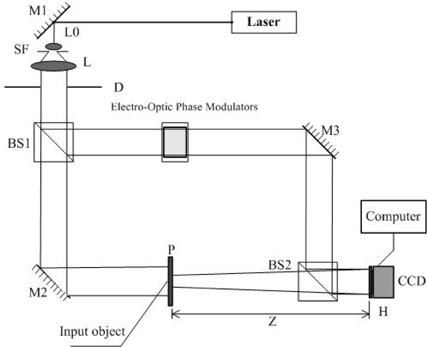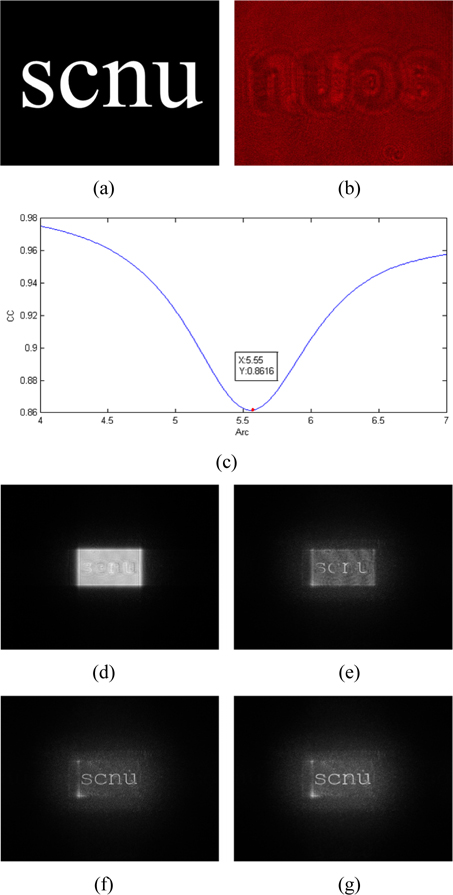



Digital holography is a technique that permits digital capture of holograms and subsequent reconstruction of the original object on a digital computer. It is also a convenient form for data transmission and object recognition [1, 2]. The major advantages of digital holography, easy and highly sensitive recording of holograms and quick reconstruction, have been realized by rapidly developing CCD and computer technologies. Digital holography has been applied to microscopy [3-5], interferometry [6-7], image encryption [8, 9], and recognition of 3D objects [10, 11], and so on.
In recent years, two-step phase-shifting digital holography has been used in optical image reconstruction because its requires fewer hologram recording [12, 13]. Tatsuki Taharae et.al experimentally demonstrated the parallel two-step phase-shifting digital holography which requires only the intensity distribution of the reference wave and spatial two phase-shifted holograms [14]. Jung-Ping Liu and Ting-Chung Poon adopted a correlation method to calculate the reference wave intensity [15]. These methods are more efficient than three or four-step phase-shifting holography, but they still need to record additionally the reference wave intensity or the object wave intensity. In this paper, we proposed an image reconstruction method with two-step quadrature phase-shifting digital holography, in which there is no need to record the reference wave intensity and the object wave intensity. In the system only two holograms are required to reconstruct the original object so it is more suitable for a real-time situation. We performed experiments to verify that our method can be used in 2D and 3D objects holography and there will not be convergence errors in CC calculation. We have applied this method well to holographic compressive imaging [16]. Section 2 introduced the principles of our method and Section 3 demonstrated the experimental results.
A typical quadrature phase-shifting holographic setup is shown in Fig. 1., where a linearly polarized laser beam is expanded, collimated, and then divided into an object beam and a reference beam. The object beam illuminates plane P, where the original image O is put on the plane P. The phase of the reference wave is controlled by an electro-optic phase modulator. Then the two waves overlap to form interferograms on the CCD plane H.
Let us assume that the plane reference wave is simply given by the real amplitude
where
Only with the two recorded interferograms
According to above image recording method, if the reference wave intensity
We find the reference wave intensity by searching all of the most possible values. From holographic imaging principle,
Where abs (
We then draw the curve of CC versus
Now in this way only two quadrature-phase holograms are needed to reconstruct the original image without zero-order image and twin-image, and the clear reconstructed image can be obtained at high speed by a certain algorithm.
The algorithm can be expressed as follows:
Replace the
Where
Moreover, from Eqs. (1)-(2), we calculate
from which, we can write
Comparing Eq. (6) with Eq. (8), we find that if
Then from Eq. (5) we can calculate the complex amplitude in the CCD plane
According to Eqs. (9)-(10), we can obtain zero-order-and twin-image-free hologram
Where
Previously, Liu
where
A series of experiments has been made to verify the feasibility of our proposed method. We shall now show a series of results based on the following conditions. The wavelength of the He-Ne laser is 632.8 nm. The quantitative bit depth of the MVC-1000 type CCD is 8 bit and the largest number of pixels is 1280 (H) by 1024 (V) with pixel size of 5.2
First we verify the validity of this method by 2D objects reconstruction experiments. The object we use is the transmission type object “SCNU”, as shown in Fig. 2(a) with the size of 1.25 cm × 1.25 cm. The parameter that we use is
Then, the 3D objects reconstruction has been tested. The object we use in this experiment is a plastic ring is as shown in Fig. 3(a) with size of 6 mm × 6 mm × 6 mm. The parameter is
To further investigate the effectiveness of our method, we reconstruct the object by four-step phase-shifting holography, as shown in Fig. 3(f). Due to the limitation of our experimental instrument, the experimental result for four-step phase-shifting digital holography is not ideal. However, with this limitation, the reconstruction result by the two-step phase-shifting holography method is better than the reconstruction result by four-step phase-shifting holography. Therefore, in the low-level optical equipment conditions, two-step phase-shifting holography can work better than four-step phase-shifting holography. And our method will also get ideal results in the high precision equipment conditions as well as in four-step phase-shifting holography. So the method proposed in this paper is effective not only in the high precision equipment conditions but also in the low-level optical equipment conditions. The results of the experiments show that our method not only can be applied to 2D object reconstruction, but also can be applied to 3D object reconstruction.
In this paper the two-step phase-shifting digital holography based on the calculated intensity of reference wave algorithm is proposed. With only two captured quadrature-phase holograms known, in addition to the acquired reference-wave intensity, which is not directly recorded in advance but calculated from CC method with two holograms, the clear retrieved image can be reconstructed at high speed. We can obtain clear reconstruction images without reference-wave intensity or object-wave intensity measurement. In the traditional two-step phase-shifting digital holography method, object wave intensity and the reference wave intensity need to be recorded to reconstruct the original image. Due to the high storage requirement of image data and long recording time, these methods have some difficulty particularly in real-time dynamic measurement. Compared with traditional two-step phase-shifting digital holography, our method just need to calculate the reference wave intensity by the CC method instead of recording object wave intensity and reference wave intensity. In this method, our system need to record only two quadrature phase holograms and we don't need to record other data on the CCD plane. It greatly reduces the recording time. For real-time dynamic measurement, we just need to modulate the phase rapidly by phase shifter and get synchronization measurement on the CCD plane to achieve real-time dynamic imaging. In addition, our method can also be used in one-step parallel phase-shifting digital holography to simplify the system. So, this proposed method can improve the speed of holographic imaging and can be considered as a real-time solution. For 3D objects, two-step phase-shifting holography works better than four-step phase-shifting holography. It reduces by half the storage requirements of the digital hologram. The results of the experiments show that the algorithm we proposed is effective. We believe that the method proposed in this paper will be widely used in parallel holography [17,18], and will provide an effective solution to the real-time and dynamic holographic field.













